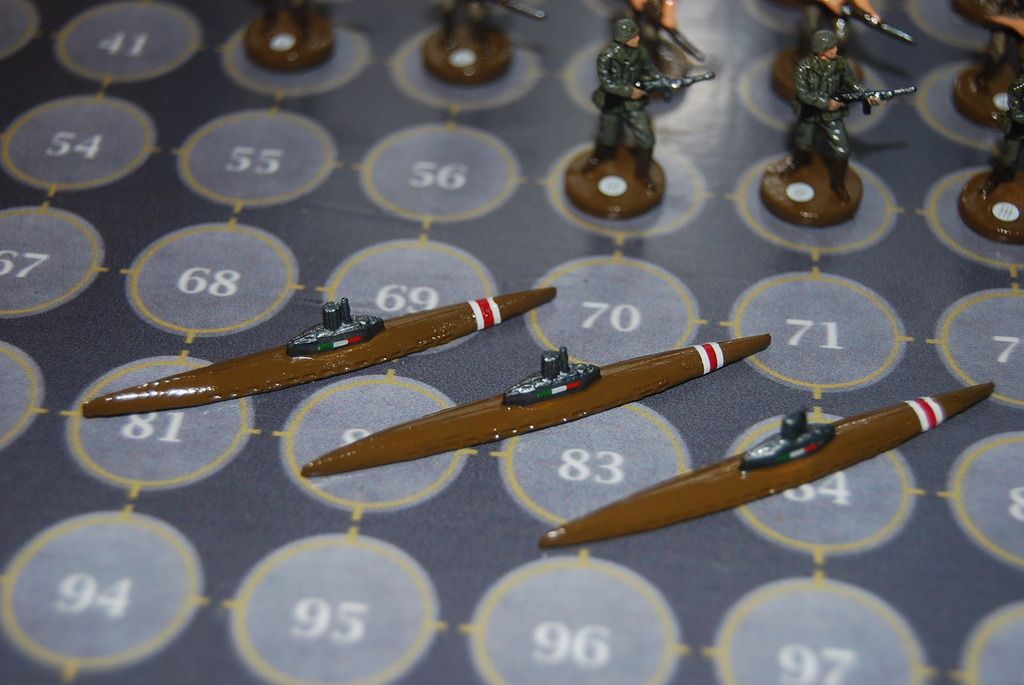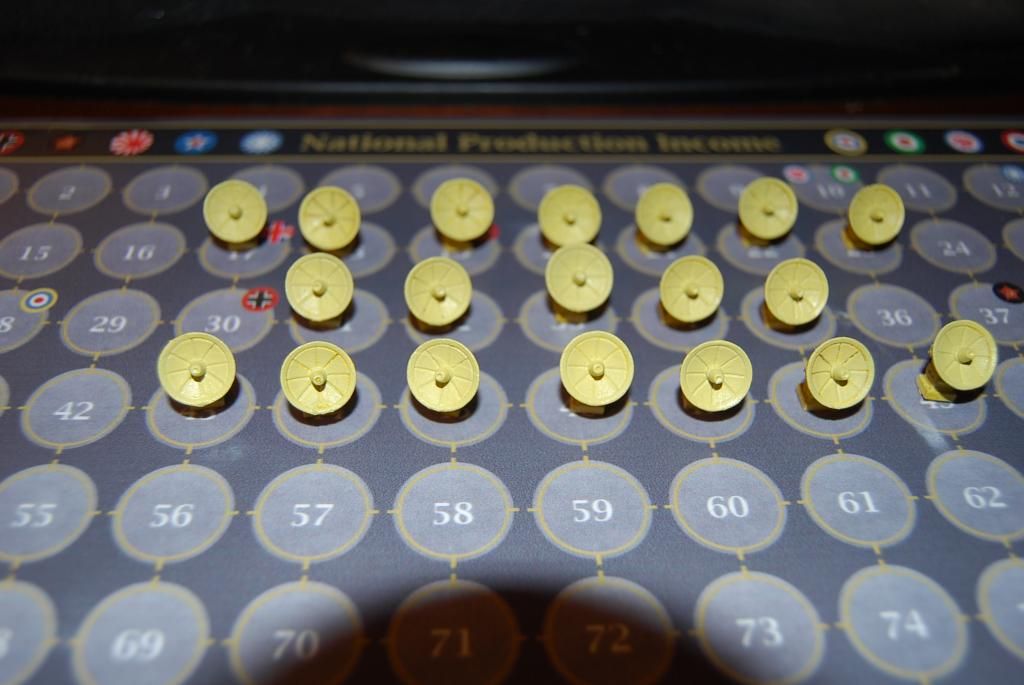Balance 1942.2 with no changes other than adding units to the starting position? Challenge accepted!
Soviets: +1 Factory Soviet Far East, +1 bomber Moscow
Germans: +1 Factory Norway, +1 destroyer Baltic Sea (SZ 5)
British: +1 Factory Eastern Australia, +1 artillery India
Japanese: +1 Factory New Guinea, +1 tank Manchuria
Americans: +1 Factory Sinkiang, +1 AAA gun Szechuan, +1 DD in Panama Canal
Here’s my reasoning: the German factory in Norway actually pulls the Germans to the northwest by quite a bit – it ties them up defending (or at least trading) the factory. The British and the Americans would very much like to take the Norwegian factory and use it themselves, so the Germans will be less willing to abandon Norway and Finland without a fight just for the sake of seizing Karelia on G1 or G2. Meanwhile, the extra German destroyer in the Baltic gives the Germans two new options for naval builds. First, they can put a carrier in the Baltic – with SS, DD, CA, CV w/ 2 ftr, and 1 trans in the Baltic, it’s going to be a long time before the Allies can sink the Baltic fleet, and a $14 naval buy on G1 won’t break the German offensive against Russia. Two, they can spend $15 to put a transport and a DD in the Baltic, for a fleet of something like SS, DD * 2, CA, 2 trans. If the British want to sink it, they have to send their entire starting London air force (2 ftr + 1 bmr), which means there’s nothing left to sink any German subs in the North Atlantic, and the British still might lose. Even if the British win the battle and sink the Baltic fleet, they could easily be left without any surviving fighters, making a B1 carrier buy extremely dicey – the Germans might be able to retaliate by sinking the new British fleet on G2, or the British might be forced to avoid a B1 fleet buy altogether. The British might even have to wait until B3 to get a fleet in the water if they lose their starting fighters. As another plus for the Germans, if they hold the Norway factory and the British decide to put 100% into the Pacific, then the Germans have the ability to drop transports into the Norwegian Sea (SZ 3), which is only one turn’s move from Eastern Canada.
Meanwhile, the Russian factory in the Soviet Far East gives Japan a lot to think about – if you build a tank in the Soviet Far East factory on R1, then you can afford to stack 4 inf, 1 tnk there (leaving 1 inf in Buryatia to block the new Manchurian tank), which is pretty defensible against the maximum Japanese attack of 1 inf, 1 tnk, 2 ftr, 1 bmr – the Japanese can take the factory if they really want to, but not without heavy losses (2+ hits) in the air, and not without leaving themselves vulnerable to an R2 retake, with, e.g., the 2 Russian infantry that start in Evenki and the new starting Russian bomber. If the Japanese do eventually secure the SFE factory, then it’s useful for a campaign against Alaska and Western Canada (although not especially useful for a tank drive to Moscow). If they don’t secure the SFE factory, then they have to leave a garrison in Manchuria and let the Allies keep most of the Russians’ Siberian income – it’s very hard to take Siberia with that factory sitting on your back door!
The Japanese factory in New Guinea, like the German factory in Moscow, is at least as much of a liability as it is an asset – if the Japanese can hold it, then it can help re-fill transports that are heading to Hawaii, Australia, Mexico, or Brazil, but it’s just as likely that the Americans (or the British) will be able to take back New Guinea, forcing the Japanese to defend a fixed point or cede an asset to the Allies that will help with a KJF campaign. Together with the starting factory in Eastern Australia, which helps give the Australian continent some thematic and strategic importance, this should help push the focus of Japanese attention out away from Egypt and back toward Guadalcanal, where the battle for the Pacific was historically fought and won.
The British artillery in India helps shore up India against a Japanese blitz, and, more importantly, gives Britain some modest but important offensive options in the Pacific theater on B1 and B2. They can use the Indian transport to ferry 1 inf, 1 art to Egypt (combined with the 1 inf in Trans-Jordan and the fighter on the Indian carrier, that makes 2 inf, 1 art, 1 ftr for a counter-attack on Egypt, which is likely to overwhelm anything that the Germans can manage to leave standing in Egypt on G1). They can use the transport to carry 1 inf, 1 art and attack Borneo with good odds. They can stack up in Burma with 4 inf, 1 art, 1 ftr, 1 AAA, or they can immediately use the Indian transport to attack French Indochina with 2 inf, 1 art, 1 ftr, 1 CA (50-50 odds).
The American destroyer in the Panama canal can be used to successfully counter-attack German submarines on A1 if the subs hit the American Atlantic fleet on G1. In my opinion, the problem with the OOB German attack on the US transports isn’t just that the Americans are forced to lose a lot of expensive ships – it’s also that the position of the German subs makes it extremely awkward to remove them! You really don’t want to send the British Canadian destroyer south to clean up subs; that destroyer is needed as the nucleus of a new British Atlantic fleet. But if you don’t send the Canadian DD, and the only American DD in range is dead, then the fastest the Americans can hope to progress is to build a new DD on A1, attack the German subs on A2, and then finally start Operation Torch (attacking North Africa) on A3. With an extra DD waiting in Panama (plus the usual CA, plus the American air force), the Americans can trivially kill off the German subs on A1, build new transports on A1, and start Operation Torch on A2 – a full turn earlier, and therefore early enough to “catch up” with the Germans in Africa before they plunder all of Africa. Of course, if the Germans don’t attack the American fleet on G1, or if you prefer a KJF strategy, the destroyer and cruiser in Panama can also reach the San Francisco sea zone on A1 to help bulk up your fleet there, so that you can drop a fleet in the San Francisco sea zone on A1 that’s likely to be able to move to the Solomon Islands on A2 – again, a full turn ahead of the typical OOB schedule.
Finally, the American AAA gun in Szechuan means you can get 50-50 odds against the maximum attack of 1 inf, 1 art, 2 ftr, 1 bmr just by adding the 1 Russian infantry from Kazakh – no need to send a Russian tank or fighter. The factory in Sinkiang means that if Japan passes up the attack on Szechuan, you can withdraw in good order to Sinkiang on A1, build a tank in the Chinese factory, and wind up with something like 4 inf, 1 tnk, 1 ftr, 1 AAA, depending on how many Russian infantry you want to use as reinforcements on R2. If Japan really wants to attack that stack on J2, then Japan is going to have to sacrifice something important: either multiple fighter casualties, or let Russia keep its factory in Vladivostok, or ease up on India to the point where Britain can start going on the offensive, or let the Americans have the New Guinea factory. The point is that now it’s not just the Allies who have impossibly many targets to secure on the first couple of turns – now the Axis do too!
Technically, the overall “bid value” is 74 IPCs for the Allies and 42 IPCs for the Axis, meaning a net bid of $32 for the Allies, but all of these bids are so sub-optimal compared to what a traditional bidder would choose that I hardly think it’s worth the effort of counting it up.


















